Entries from October 1, 2016 - October 31, 2016
UK money trends strong, nominal GDP to accelerate further
The UK economic outlook was uncertain in the wake of the Brexit vote. The provisional assessment here was that the economy would slow significantly but that official / consensus forecasts of stagnation or recession would be proved wrong. This assessment, however, was subject to revision depending on post-referendum monetary trends.
Three months on, it appears that the provisional assessment was unduly conservative. Monetary trends have remained strong since the referendum and suggest rising nominal GDP growth with stable real-terms expansion.
The preferred narrow and broad monetary aggregates here are non-financial M1 and M4, covering money held by households and private non-financial firms. M1 comprises notes / coin and sterling sight deposits; M4 also includes sterling time deposits, money funds, repos and short-term bank securities. These measures grew at annualised rates of 10.5% and 7.8% respectively between end-June, just after the referendum, and end-September. The Bank of England’s M4ex broad money aggregate expanded at a 10.0% rate over the same period, boosted by rapid growth of deposits held by insurance companies / pension funds, unit / investment trusts, other fund managers and securities dealers – movements in such deposits, however, contain little information about near-term economic prospects (hence the preference here for non-financial money measures).
12-month growth rates of non-financial M1, non-financial M4 and M4ex were 10.2%, 6.8% and 7.7% respectively in September. The two broader aggregates are rising at their fastest pace since 2008. Non-financial M1 growth exceeded 10% between May 2013 and June 2014, ahead of several quarters of strong nominal and real economic expansion.
The 12-month growth rates have been trending higher since early / mid 2015. Swings in non-financial M1 growth have consistently led those in nominal GDP expansion in recent years – see first chart. Annual nominal GDP growth rose between the third quarter of 2015 and the second quarter of 2016, and is likely to have increased further last quarter, based on last week’s preliminary real GDP estimate. (A first estimate of nominal GDP for the third quarter will be released on 25 November.) Monetary acceleration suggests that the pick-up will extend into spring 2017, at least.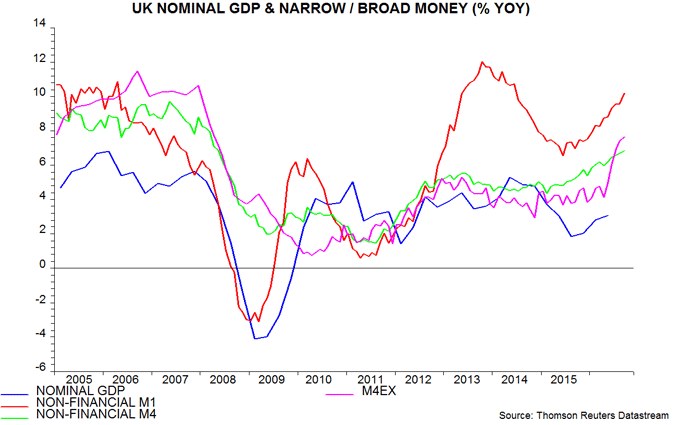
Faster nominal GDP growth is likely to be driven by higher inflation, with output expansion broadly stable. The second chart shows two-quarter / six-month changes in real GDP and the money measures deflated by consumer prices. Growth of real non-financial M1 / M4 remains strong but has moderated slightly, reflecting a recovery in consumer price momentum. GDP may continue to rise at its recent pace of 2-2.5% annualised through next spring. The consensus forecast of 1.0% growth in all of 2017 (October Treasury survey, revised up from 0.7% in September) looks much too low.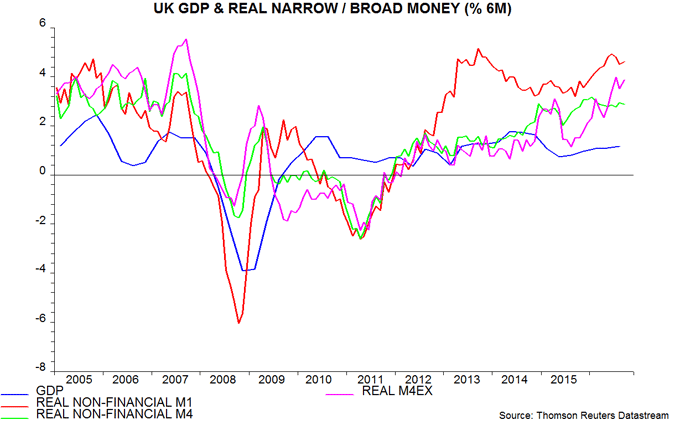
Eurozone money trends suggesting steady growth
Eurozone monetary trends remain positive but are no longer strengthening, suggesting stable GDP growth at around its recent pace of 0.4% per quarter, i.e. 1.5-1.75% annualised. This is above most estimates of potential, implying a continued decline in unemployment. Economic prospects may be improving in Spain / Italy relative to France / Germany, based on country narrow money data.
Annual growth of Eurozone-wide M3 was 5.0% in September and has moved sideways since early 2015. Annual M1 growth, however, has fallen from a peak of 11.8% in July 2015 to 8.5% in September. The combination of stable M3 expansion with slowing M1 has led some commentators to suggest that economic growth prospects have deteriorated at the margin.
The M3 and M1 numbers, however, have been pulled down by a sharp slowdown and recent small contraction in financial institutions’ deposits, possibly reflecting further reductions in interest rates – such deposits contain little information about near-term economic prospects. Annual growth of non-financial M1 – comprising holdings of households and non-financial corporations (NFCs) – was stronger than that of M1 in September, at 9.1%, and has slowed by less. Non-financial M3 growth, meanwhile, rose to 5.6% last month, its fastest since 2008 – see first chart.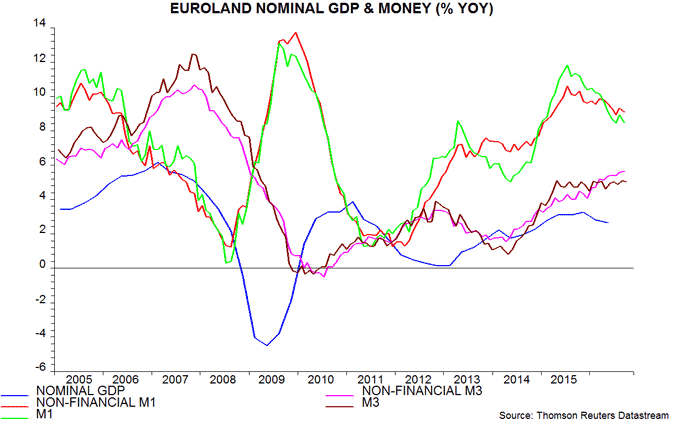
Economic growth prospects depend on real rather than nominal monetary trends. Six-month growth rates of non-financial M1 and M3, deflated by consumer prices, have moderated recently but remain solid by recent and longer-term standards – second chart. The slowdown would need to extend significantly further to suggest weakening prospects, on the judgement here.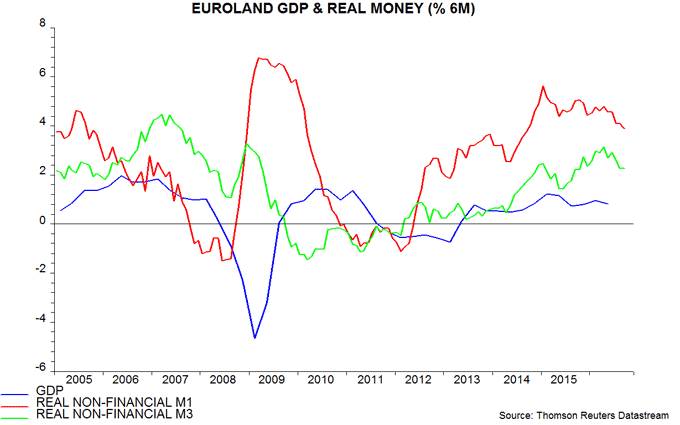
The decline in real narrow money growth has been focused on France and, to a lesser extent, Germany, with Spanish and Italian trends remaining upbeat, based on country data on overnight deposits – third chart. This may signal improving relative economic and equity market prospects for Spain / Italy, and deteriorating reelection prospects for President Hollande.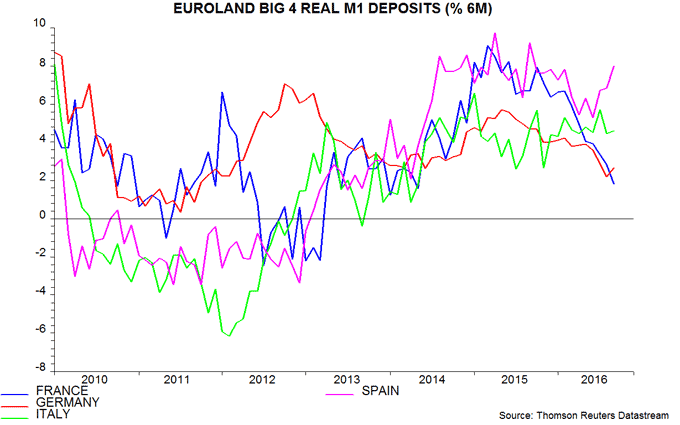
Solid UK Q3 GDP questions MPC easing
The preliminary estimate of a 0.5% rise in GDP in the third quarter raises further doubts about the MPC’s pre- and post-Brexit vote economic analysis and should extinguish any remaining expectations of an additional cut in Bank rate. There is, indeed, a case for suspending the current QE programme to reflect the much stronger economic environment than the MPC expected.
The 0.5% increase compares with a 0.4-0.5% projection here and a consensus estimate of 0.3%. Strong services growth of 0.8% over the quarter offset falls of 0.4% and 1.4% in industrial and construction output. Within services, output of “transport, storage and communications” rose by 2.2%, boosted by strength in creative activities (film, video and TV programme production, sound recording and music publishing). “Business services and finance” and “distribution, hotels and restaurants” also made significant growth contributions.
The preliminary estimate is based on only about 44% of the information that will be incorporated in the final output-based GDP measure. Historically, however, an upward growth revision has been slightly more likely than a downgrade.
Monthly output data underlying the 0.5% growth estimate imply that GDP rose steadily over the three months, with September’s level 0.1% above the quarterly average – see first chart.
GDP rose by 1.2% (2.4% annualised) in the second and third quarters combined, the fastest two-quarter growth since the fourth quarter of 2014. A pick-up in momentum had been suggested by monetary trends: six-month growth rates of real narrow and broad money (as measured by non-financial M1 and M4 deflated by consumer prices) increased in late 2015 / early 2016 – second chart.
The MPC ignored monetary trends and has misread the economy. At its July meeting, the Committee judged that the Brexit vote “was likely to depress economic activity in the near term”. It was more explicit in August, expecting “little growth in GDP during the second half”, with the Bank’s staff forecasting that the preliminary third-quarter estimate would show no change from the second quarter. Better data forced an upgrade in September but the MPC still anticipated “a material slowing of UK GDP growth”, with the staff estimating a preliminary third-quarter rise of only 0.2%.
The MPC can, at least, pass the dunce’s cap to the Treasury, which predicted that GDP would fall by between 0.1% and 1.0% in the third quarter in the event of a Brexit vote.
Global acceleration watch: business surveys
Business surveys generally provide little if any lead on economic developments and sometimes give false signals (e.g. the suggestion from the UK PMIs that output would fall in the wake of the Brexit vote*). They are, however, timely, and can be useful in confirming a change in the economic landscape, particularly when surveys in a number of countries shift simultaneously.
Such a shift appears to be occurring currently – manufacturing surveys strengthened in early October in the US, Japan, Eurozone and UK, consistent with the view here that economic acceleration is under way globally.
In the US, an average** of the new orders components of the New York and Philadelphia Fed manufacturing surveys rose sharply this month, confirming that a September rebound in the ISM new orders index was genuine – see first chart. The orders index of the alternative Markit PMI survey, meanwhile, reached a 12-month high.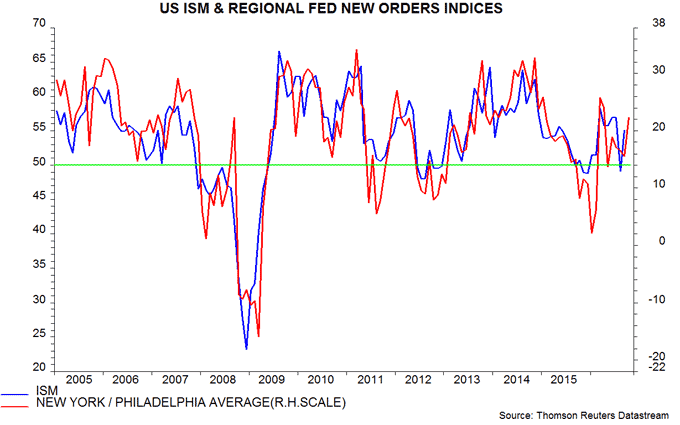
The Markit Japan PMI new orders index weakened sharply as the yen surged during the first half of 2016 but regained the 50 level – implying more firms reporting rises than falls – in October, despite an absence of currency relief. The Eurozone index has remained comfortably in expansionary territory and rose to a four-month high this month – second chart.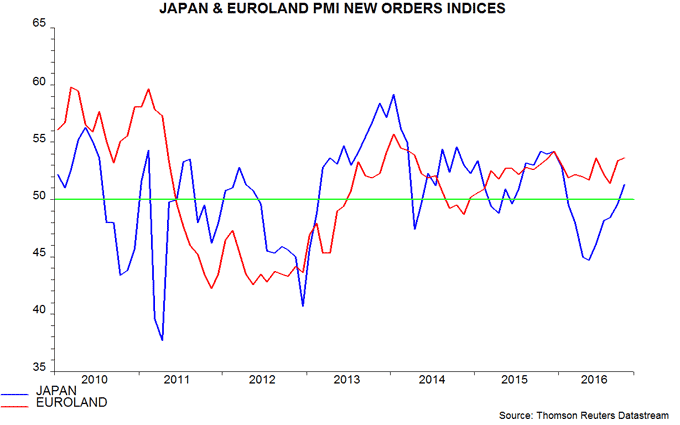
The Eurozone PMI gain was led by strength in Germany, which was confirmed by today’s Ifo survey, showing manufacturing business expectations at their highest since 2014 – third chart.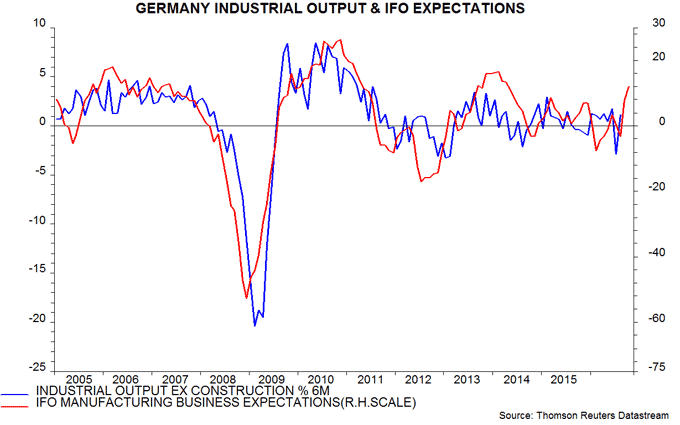
In the UK, the October CBI quarterly industrial survey reported a rebound in the expected domestic orders balance and a surge in export orders – fourth chart***. Before attributing the latter to sterling weakness, it should be noted that the percentage of firms judging pricing to be a constraint on exports was stable over the quarter, questioning Brexiter claims that a lower pound will allow UK exporters to gain market share – fifth chart. 
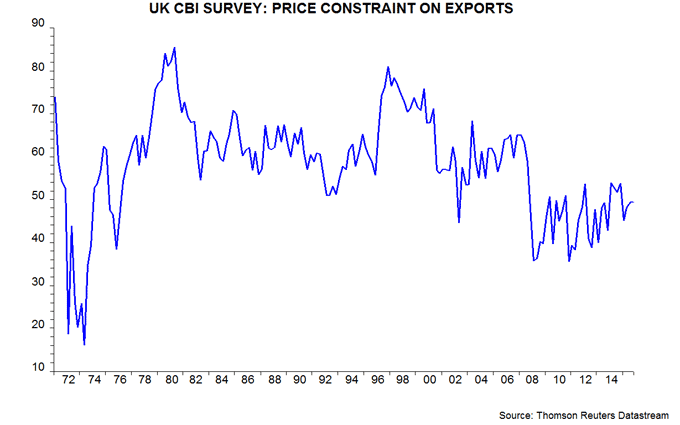 *UK GDP is estimated to have risen by 0.3% between June and July, based on sectoral output data.
*UK GDP is estimated to have risen by 0.3% between June and July, based on sectoral output data.
**Average of current and expected new order balances.
***Seasonal adjustment applied to CBI data.
Global acceleration watch: US business investment
US business investment fell by 0.5% in the year to the second quarter but is expected here to rebound during the second half and into 2017, contributing to a rise in GDP growth. Recent evidence is consistent with this forecast.
Reasons for expecting investment to strengthen include: corporate profits have recovered since late 2015; corporate bond yields have fallen significantly; capacity utilisation is little changed despite sluggish growth; money holdings of non-financial businesses are rising solidly (by 5.8% in the year to June); the corporate liquidity ratio (i.e. liquid assets divided by short-term liabilities) is above its historical average; so is Tobin’s Q ratio (i.e. the market value of equity is high relative to the replacement cost of assets, implying an incentive to invest); and capital spending cuts in the energy sector have ended.
Equipment spending accounts for 46% of business investment. Industrial output of business equipment rose in the second quarter and was stable in the third quarter. This increase suggests that next week’s third-quarter GDP release will report a recovery in equipment spending following three quarterly falls – see first chart.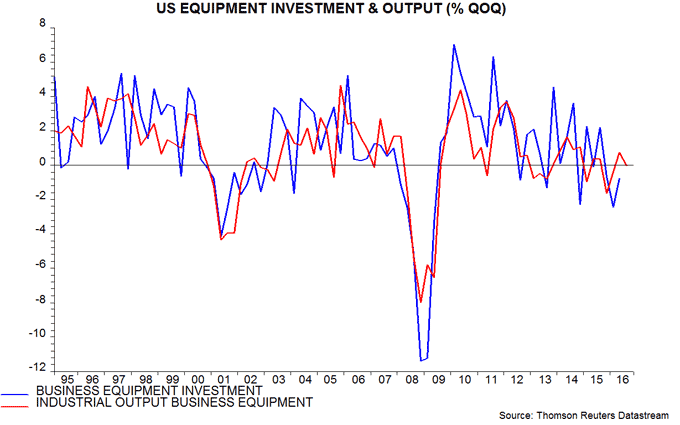
Structures investment accounts for a further 21% of the business total and has been depressed by a collapse in mining exploration. The industrial output component covering oil and gas well drilling, however, rose in the third quarter, suggesting that mining and overall structures investment returned to growth – second chart.
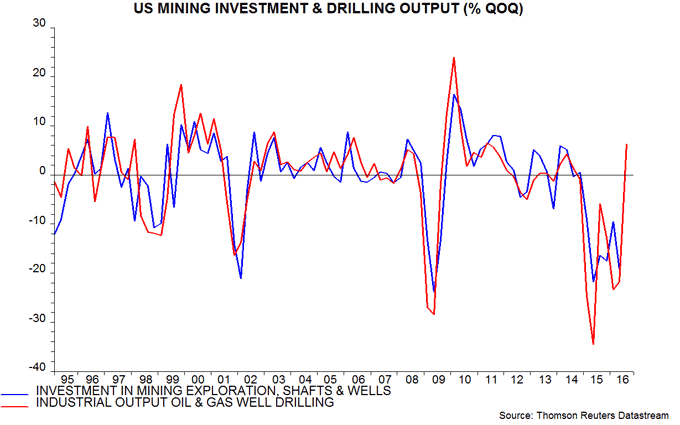
Spending on “intellectual property products”, mainly software and R&D, accounts for the remaining 33% of business investment. It rose by 4.8% in the year to the second quarter and is likely to have continued to grow strongly in the third.
UK Q3 GDP to confirm economic resilience, embarrass Treasury
Available evidence suggests that the preliminary estimate of third-quarter GDP to be released on 27 October will show quarterly growth of 0.4-0.5%, following a 0.7% second-quarter gain. This compares with the Treasury’s pre-EU referendum projection of a 0.1% GDP fall in the third quarter in the event of a Brexit vote in its milder “shock” scenario, and a 1.0% decline in its alternative “severe shock” scenario.
The 0.4-0.5% prediction reflects the following considerations:
-
GDP in July is estimated to have been 0.4% above the second quarter level, based on monthly output data for services, industry and construction.
-
The services turnover report for August released yesterday suggests that output in the sector rose slightly further (or July’s increase was slightly larger than currently estimated)*. The projected gain offsets the impact of already-reported August falls in industrial and construction output.
-
The GDP number will incorporate Office for National Statistics estimates of sectoral output in September. These estimates will be based partly on statistical models that are likely to extrapolate recent growth.
Solid third-quarter growth – if confirmed – does not, of course, imply that the Brexit vote has had no negative impact, nor that forecasts of economic weakness will not prove correct over a longer time horizon. The view here will continue to be guided by monetary trends, which suggest that growth will remain respectable through spring 2017, at least – see previous post.
The Treasury’s inaccurate projection reflects two mistakes: like most other forecasters, it significantly underestimated the economy’s momentum at the time of the vote; and its assessment of the impact of a Brexit outcome was based on implausibly negative assumptions about uncertainty effects and financial conditions. The forecast of a recession, indeed, appeared to have been reverse engineered – see previous post.
*The relationship between the turnover and output data was discussed in a previous post.

